Berkeley sedge lawn after mowing
Two weeks after I posted my 1-year assessment of the Berkeley sedge (Carex divulsa) lawn, the sedge had gone to seed, it was looking pretty rangy, and it was time to mow. Mowing it on a high setting with my battery-operated mower took all of 5 minutes and gave it a more even appearance, although parts of the lawn are still patchy.
Let’s walk the path around the lawn for 360-degree views.
This end is lush and full — exactly how I hope all of it will look eventually soon.
A quick peek down the new side garden. Deer-resistant perennials and grasses are filling in nicely over here.
Large flagstones lead through the sedge to the stone steps along the retaining wall.
The long view
The view from the steps, looking out toward the street
And back, as seen from the driveway
I’ve been impatient about its growth rate, expecting it to leap like most grasses do. But considering it looked like this a year ago in March, I’d say there’s progress.
And I’m really enjoying my new fence while I wait. Unlike plants, hardscape gives you nearly instant results, satisfying even the most impatient gardener.
All material © 2006-2014 by Pam Penick for Digging. Unauthorized reproduction prohibited.


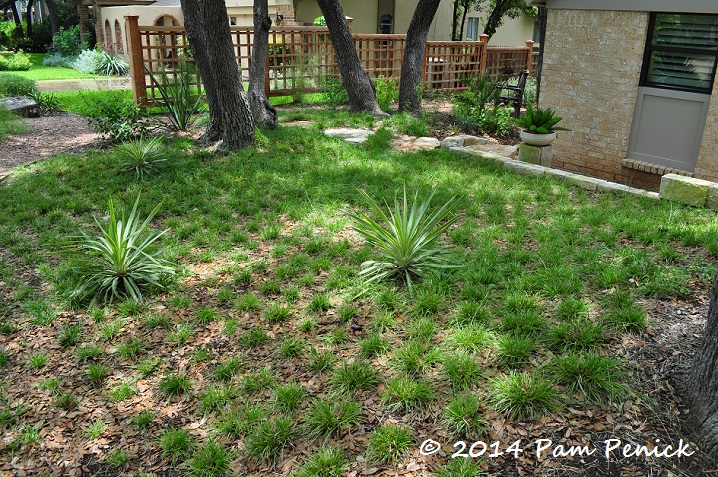
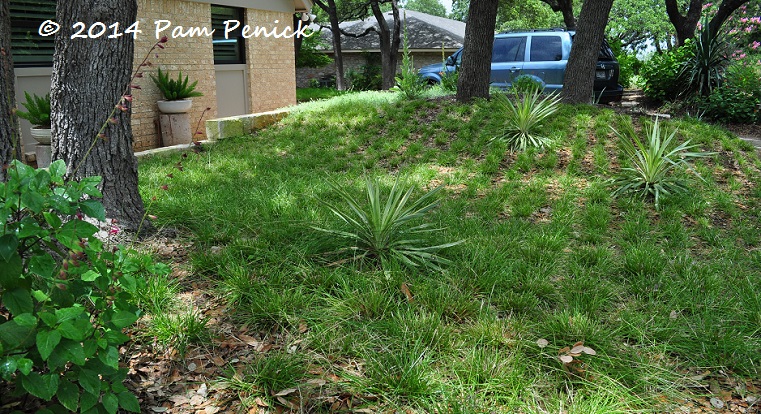
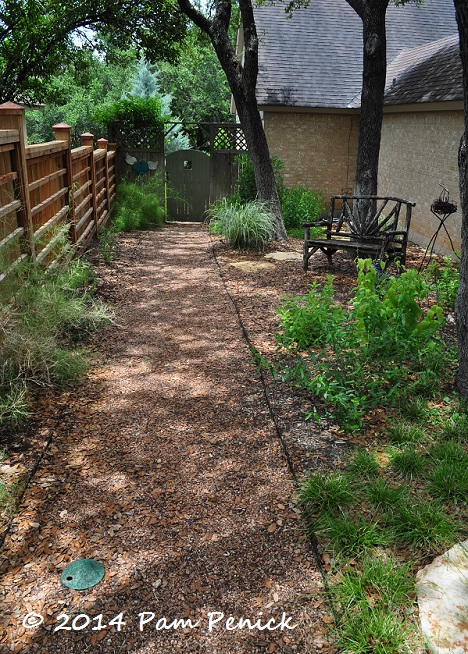
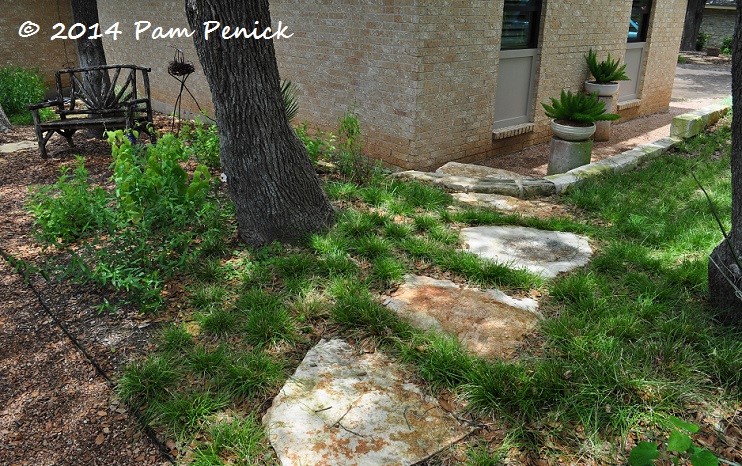
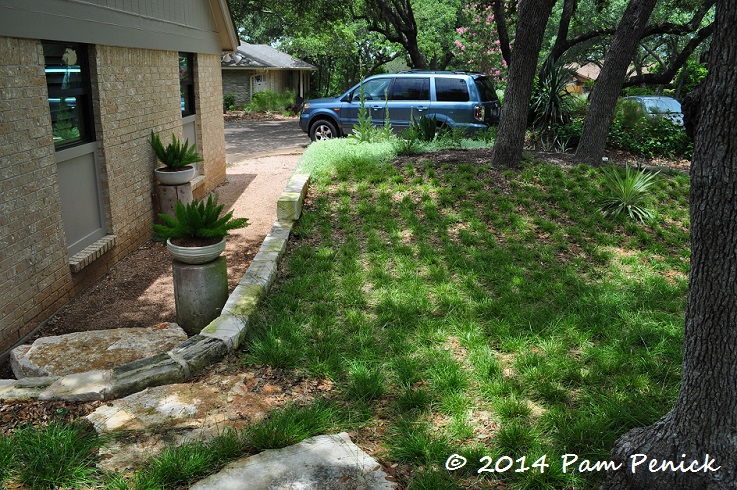
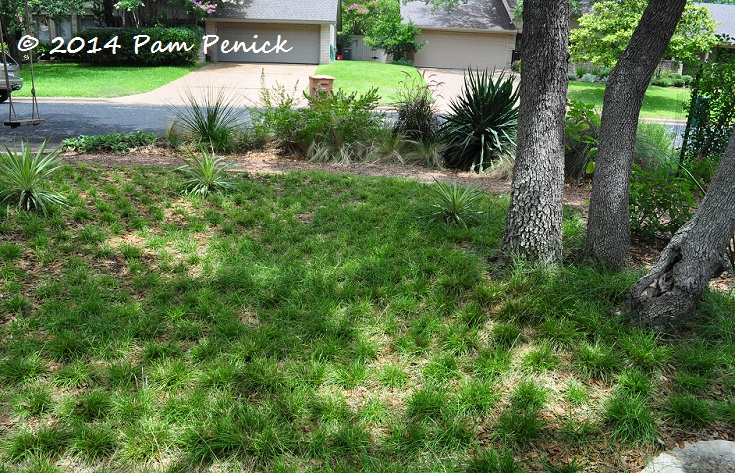
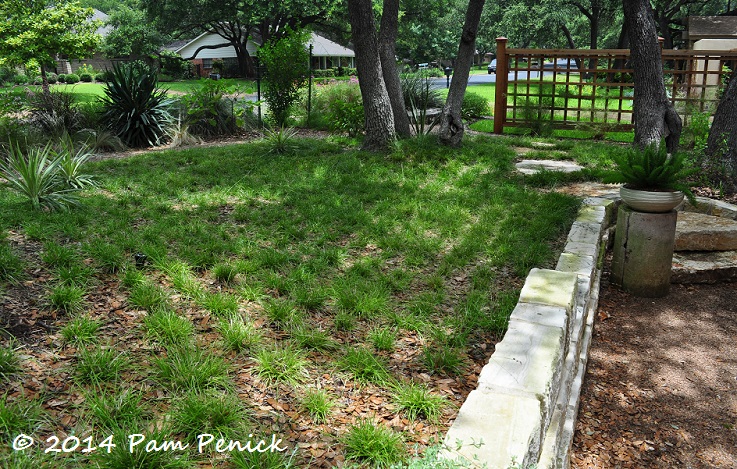
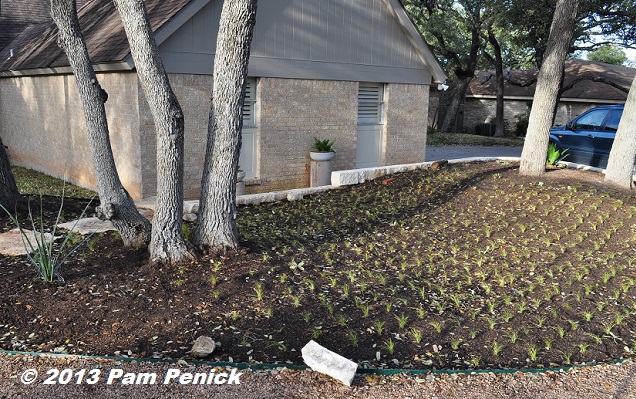
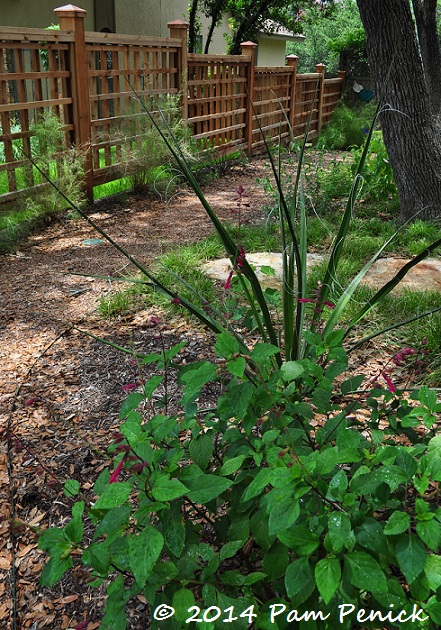
There’s definitely a lot of progress and the “just planted” photo proves it. The cooler, cloudy beginning of summer this year should help with new growth through fall. I wonder how long some of the sedge lawns on tour or in your drive-bys have been in place.
I wonder too, Shirley. Or maybe they watered more to get it established. I always suspect I let things get a little dry when I first plant, although I try to remember to get out there and hand water between official irrigation days when plants are young. —Pam
Looking pretty good I’d say! Huzzah for photos to help us recall how far an area has come when our own memories are often more reflective of our relative impatience.
Did you collect any seed before mowing to scatter on the sparser side of the area? Seems I recall you saying sedge seed was hard to find commercially and it sounds like yours just gave you some to play with.
I’m too lazy for seed collection, Deb, so I just mowed it down and let the seedheads remain where they fell. Even the sparser side had seedheads, and I hope they’ll germinate and help fill in. —Pam
Looking great, Pam! We installed a sedge lawn at a client’s a couple of years ago — it was supposed to be all Berkeley sedge, but I’m pretty sure some Texas sedge got mixed in there. At any rate, it looks good and has really filled in, creating a great little lawn for a shady area.
I remember you telling me about this one, Jenny. It can definitely be tricky to get one big swath of the same sedge, especially if you buy portions over time. See my comment to Susan below. —Pam
Gorgeous fence! And thanks for doing the experimentation with the carex. It’s such a promising genus for alternatives to turfgrass but there’s limited info on them, and it all has to be regionally similar to where we are.
Yes, there is a definite shortage of information AND availability where sedge is concerned. My supplier told me that this problem is compounded by the fact that some sedge species, which prefer very different conditions, are virtually indistinguishable except by examining their seed under a microscope, with the result that sedges are often incorrectly labeled and sold. —Pam
Ooooo, Yes, I love your new fence. It looks great. Your lawn will look good all over in no time. I know that feeling of impatience. It’s time will come. I like those big stone pavers too.
Even though it looks sparse in sections to your eye, Pam, it looks great from my perspective. My current lawn has a lot more holes in it than yours – and most of mine isn’t green either. Carex divulsa of C. pansa are possible replacements for the areas of lawn I’d like to keep but I’m also considering UC verde buffalo grass (Buchloe dactyloides).
It sounds like you have several good options, Kris. —Pam
I planted Berkeley sedge along a path 4 years ago in sun to mostly shady conditions here in Tulsa and just as in your planting some have flourished and some have languished. They are dying out in the middle so I will be dividing them and spreading them out in the yard. Maybe they will find a “happy” place! Thanks for keeping us up to date as I have been curious about how your sedge is doing, maybe finding a clue as to what to do about mine.
Carol, I have seen numerous successful Berkeley sedge lawns here in Austin (always in shade), and so I’m surprised that mine is taking so long to establish. But while slow, it is coming along. I hope yours will too. —Pam
Looks good.
Seems to be filling in pretty well.
Having the ‘just planted’ photo, really shows the progress.
We have native sedge grass growing in shady areas of our property. Love it and trying to encourage its spread. (We live just north of Waco)
Lots of progress! I’ve always wondered what a lawn like this looks after mowing thanks for the images. Earlier this spring I had a friend comment on how bad my black mondo grass along the front sidewalk was looking. She told me I should mow it down but my heart skipped a beat at the thought.
Hmm, I hope she’s a good friend and not a garden nitpicker! 🙂 —Pam
I love black mondo and almost planted it instead of my Carex texensis. I saw a yard in New Orleans with a “lawn” of it. I chose the native grass because it grows well in full shade. I never planned to mow it However, I had to take my trees down and it went NUTS in the sunshine. Much taller than I like it. Plus I over seeded wildflowers. Just mowed it today (mostly just to deadhead the flowers)- not happy with the look but it will grow back.
I think you made a wise decision, Sheryl. The black mondo grass gets pretty stressed in our heat and drought, from what I’ve seen. —Pam
That new fence looks great. And I think the sedge is coming along nicely. Once a year mowing – sounds good to me!
Actually looking pretty good, Pam. That fence calls out for some evergreen vines, coral honeysuckle maybe, or confederate jasmine?
Nope, I designed it to be open rather than wall-like, and a vine, though pretty, would close it off to breezes. I’m keeping it bare. —Pam
It’s definitely filling in…taking a while, but filling in, nonetheless.
I wrote on carex a while back. As susan says much promise. There is a carex for any spot. http://www.houzz.com/ideabooks/21227186/list/Meet-a-Lawn-Alternative-That-Works-Wonders
Pam, you inspired me to mow mine (with the neighbors mower.) If you’ve been by you know that I over seeded wildflowers this year – made it into a meadow more than a lawn. It looked really cool but it became straggly right at the end of June. I waited for about 30% to ripen and then mowed. I scattered the clipping back on the lawn to help retain moisture and reseed. My version of a buffalo herd.
It looks like hell right now but will be interesting to see how quickly it recovers in this heat.
Thanks for the post and for virtually gardening with me!
“My version of a buffalo herd.”
Ha! Yes, native grasses were kept in check by herbivores in the old days, weren’t they? And by fire, but we’ll leave that to the Wildflower Center’s controlled burns. An occasional mowing suits my purposes too. —Pam
Pam, this is solution I’ve been looking for in my front yard! Thanks for the detailed explanations of how you made it happen. I have two mature live oaks that provide great shade, but the grass really struggles to grow. What will happen to the sedge as the leaves and acorns continue to fall? Will it be difficult to blow/clean it out when the sedge is more full grown? I’m concerned that if I just leave the leaves that they will not decompose from one year to the next…
Tyler, I’d advise you to blow out most of the leaves the first year as the sedge is getting established (my live oak leaf drop was smothering the tiny sedges the first spring), but thereafter it shouldn’t be a problem. —Pam